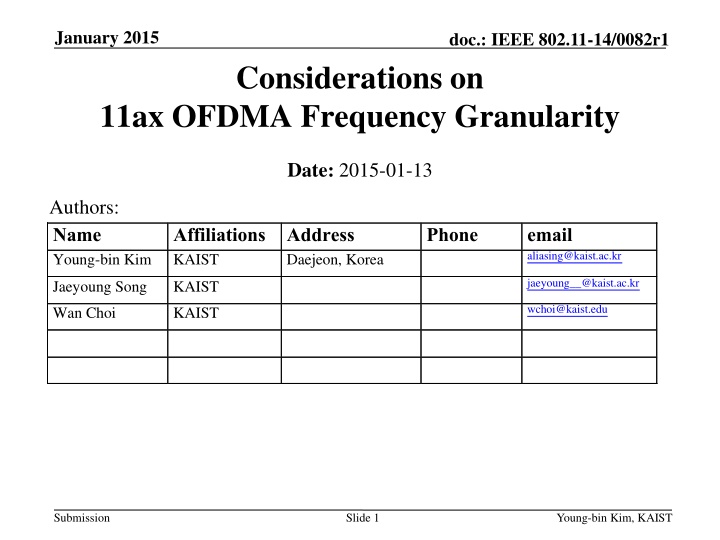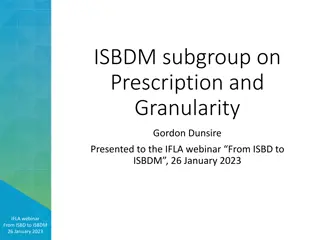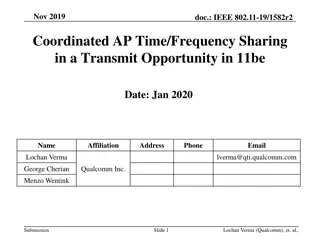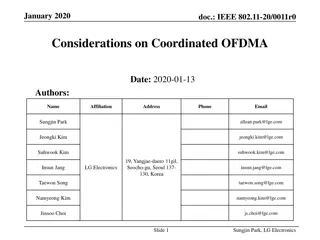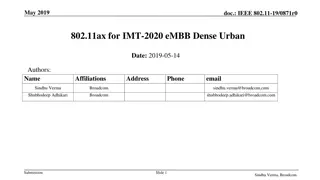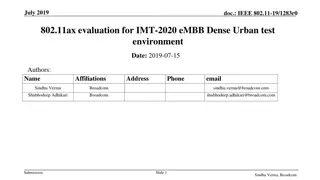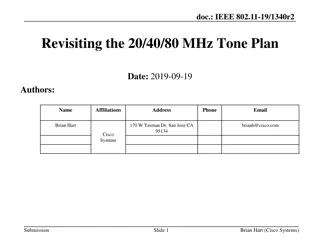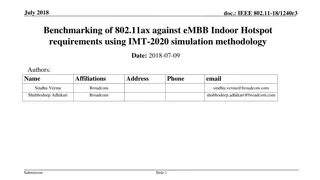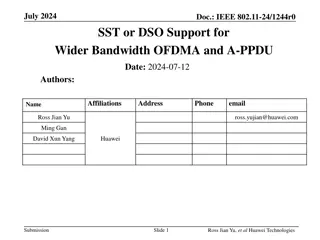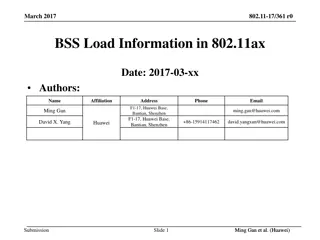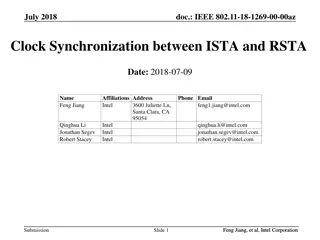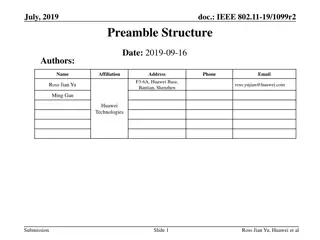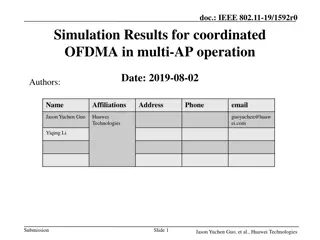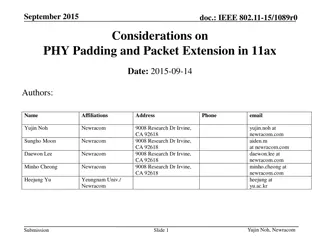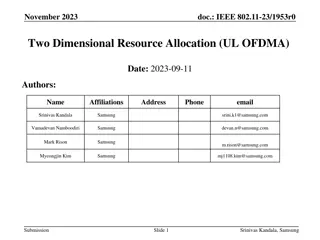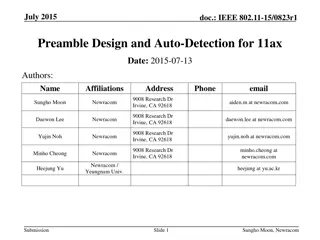Considerations on 11ax OFDMA Frequency Granularity
This document discusses the OFDMA frequency granularity considerations for IEEE 802.11ax, focusing on parameters, subcarrier allocation, FFT size, guard band spacing, and sub-bands. It explores the potential resource granularity, throughput improvement, subband determination, and subcarrier allocation parameters in detail.
Download Presentation

Please find below an Image/Link to download the presentation.
The content on the website is provided AS IS for your information and personal use only. It may not be sold, licensed, or shared on other websites without obtaining consent from the author.If you encounter any issues during the download, it is possible that the publisher has removed the file from their server.
You are allowed to download the files provided on this website for personal or commercial use, subject to the condition that they are used lawfully. All files are the property of their respective owners.
The content on the website is provided AS IS for your information and personal use only. It may not be sold, licensed, or shared on other websites without obtaining consent from the author.
E N D
Presentation Transcript
January 2015 doc.: IEEE 802.11-14/0082r1 Considerations on 11ax OFDMA Frequency Granularity Date: 2015-01-13 Authors: Name Young-bin Kim Affiliations Address KAIST Phone email aliasing@kaist.ac.kr Daejeon, Korea jaeyoung__@kaist.ac.kr Jaeyoung Song KAIST wchoi@kaist.edu Wan Choi KAIST Submission Slide 1 Young-bin Kim, KAIST
January 2015 doc.: IEEE 802.11-14/0082r1 Background For 802.11ax, DL/UL OFDMA is one of key techniques for supporting MU transmission[1]. Based on the analysis on the multi-user & frequency diversity gain, there has been proposed that 4 or 8 subbands for 20MHz as a potential resource granularity [2]. New OFDM numerology with 4 times FFT size for 20MHz is also proposed for 802.11ax 256 FFT size with normal 0.8us CP length in 20MHz BW can provide about 17% throughput improvement over that of 64 FFT size by CP overhead reduction [3-5]. In this contribution, we consider further details on frequency granularity for OFDMA with 256 FFT. Young-bin Kim, KAIST Submission Slide 2
January 2015 doc.: IEEE 802.11-14/0082r1 Parameters for 11ax PHY Structure Basic Parameter Set of 20 MHz for 11ax PHY [1-5] Values Parameters Bandwidth 20 MHz (Other BWs need to be extended) Subcarrier frequency spacing 78.125 kHz (256 FFT), 312.5 kHz (64 FFT) IDFT/DFT period 12.8 us (256 FFT), 3.2 us (64 FFT) Guard interval duration 0.8us, Other CPs to be considered Number of frequency segments/subbands 4 or 8 (256 FFT), 1 (64 FFT) Need to determine the subcarrier allocation parameters The number of subcarriers for guard band in 256 FFT for 20 MHz BW The total number of used subcarriers for data and pilots The number of subcarriers per subband Submission Slide 3 Young-bin Kim, KAIST
January 2015 doc.: IEEE 802.11-14/0082r1 Subcarrier Allocation for 256 FFT Guard Band Spacing Spectral mask for 11ac was proposed in [6] For 20MHz, +/-9 for 0dBr, +/-11 for -20dBr, +/-20 for 28dBr, and +/-30 for -40dBr The used subcarriers are allocated in flat region. In the ac case for 20MHz band, there are 56 used subcarriers. At least, 224 subcarriers can be considered in ax for 256FFT. For ac, considering a subcarrier for DC, 7 subcarriers are allocated for guard band (about 2MHz). For ax, at most 12~16 subcarriers (937.5KHz~1.25MHz) can be considered for guard band. Submission Slide 4 Young-bin Kim, KAIST
January 2015 doc.: IEEE 802.11-14/0082r1 Subcarrier Allocation for 256 FFT The number of sub-bands In [2] and [7], OFDMA based on 2.5MHz or 5MHz (8 and 4, respectively) subband is considered according to channel models in order to obtain high throughput gain improvement over OFDM exploiting multi-user and frequency selective diversity. In the next step, the number of subcarriers per sub- band needs to be determined commonly for 2.5MHz and 5MHz subband to reflect flexibility of resource allocation according to channel models. Submission Slide 5 Young-bin Kim, KAIST
January 2015 doc.: IEEE 802.11-14/0082r1 Subcarrier Allocation for 256 FFT The number of used subcarriers per subband The number of used subcarriers per subband is designed to be equally allocated to each subband for user fairness. 56, 57, and 58 subcarriers for 5 MHz subband Let n= # of used subcarriers per subband {256-(16+15+1)}/4 = 56 n 58={256-(11+10+3)}/4 DC GB For flexible resource allocation between 2.5 and 5 MHz subbands, even number can be considered, i.e., 57 is excluded. 56 and 58 are candidates for the 4 subband case. Submission Slide 6 Young-bin Kim, KAIST
January 2015 doc.: IEEE 802.11-14/0082r1 Subcarrier Allocation for 256FFT The number of pilot subcarriers per subband Coherence BW according to channel modes [8] 0.5-Coherence BW (MHz) # of Scenario DS (ns) Parameters subcarriers LOS 65 3.08 39 UMi NLOS 129 1.55 19 O-to-I 240 0.83 10 LOS 93 2.15 27 UMa NLOS 363 0.55 7 Supporting outdoor channels, more pilots seem to be needed but comparable pilot overhead with legacy system is also necessary. Since pilot overhead of 11n/ac for 20MHz BW is 0.071, at most 4 pilots per 5MHz subband can be considered. (4/58=0.071, 4/56=0.069) Submission Slide 7 Young-bin Kim, KAIST
January 2015 doc.: IEEE 802.11-14/0082r1 Subcarrier Allocation for 256 FFT: Summary Parameters for 20 MHz Option1 for ax Option 2 for ax 11 a/g 11n/ac # of complex data numbers per frequency segment (subband) 52 or more 54 or more 48 52 # of pilot values per frequency segment (subband) 4 or less 4 or less 4 4 Total # of subcarriers per frequency segment (subband) 56 58 52 56 # of frequency segment (subband) 4 or 8 4 or 8 1 1 Subcarrier frequency spacing 78.125 KHz 78.125 KHz 312.5 KHz 312.5 KHz IDFT/DFT period 12.8 us 12.8 us 3.2 us 3.2 us 15(1.17MHz) /14(1.09MHz) or 16(1.25MHz) /15(1.17MHz) 11(859.4KHz) /10(781.3KHz) or 12(937.5KHz) /11(859.4KHz) # of subcarriers for guard band (left/right) 4(1.25MHz) /3(937.5KHz) 4(1.25MHz) /3(937.5KHz) Pilot overhead 4/56=0.071 4/58=0.069 4/52=0.077 4/56=0.071 Submission Slide 8 Young-bin Kim, KAIST
January 2015 doc.: IEEE 802.11-14/0082r1 Subcarrier Allocation for 256 FFT: Summary The example for 256 FFT with 20MHz BW Submission Slide 9 Young-bin Kim, KAIST
January 2015 doc.: IEEE 802.11-14/0082r1 Conclusions Considering OFDMA with 256FFT for 20MHz bandwidth, the candidate parameters for frequency granularity can be as follows: Sub-band partitioning: 4 or 8 # of subcarriers for guard band: at most 12~16 # of used subcarriers per frequency segment: 56 or 58 # of pilot subcarriers based on pilot overhead: less than 4 Submission Slide 10 Young-bin Kim, KAIST
January 2015 doc.: IEEE 802.11-14/0082r1 References [1] 11-14/1453r2, Spec Framework Proposal [2] 11-14/1227r3, OFDMA Performance Analysis [3] 11-14/0804r1, Envisioning 11ax PHY Structure - Part I [4] 11-14/0801r0, Envisioning 11ax PHY Structure - Part II [5] 11-14/1228r2, Issues on 256-FFT per 20MHz [6] 11-10/1109r1, Spectral Mask and Flatness [7] 11-14/1452r0, Frequency Selective Scheduling in OFDMA [8] 11-14/0882r4, IEEE 802.11ax Channel Model Document Submission Slide 11 Young-bin Kim, KAIST
